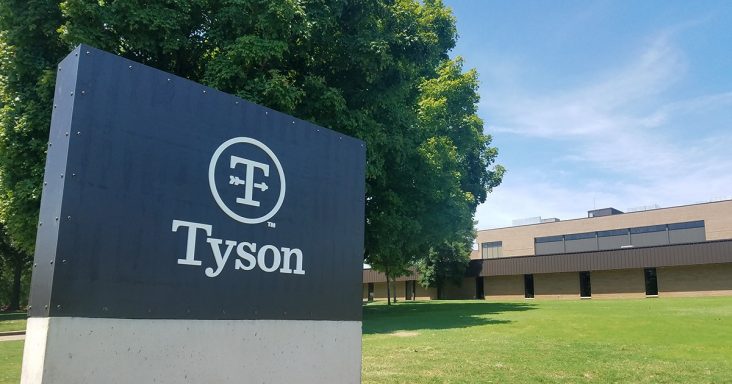Tyson Foods’ earnings beat estimates; company notes ongoing labor and inflation issues
by February 7, 2022 11:35 am 731 views

Tyson Foods surprised market watchers Monday (Feb. 7) with net income of $1.21 billion, up 140% from a year ago. The company blew past the consensus earnings per share estimate of $1.90 with adjusted earnings per share of $2.87. Revenue was $12.9 billion, up 24% from the year-ago period, and better than the $12.18 billion consensus estimate.
Despite an overall 18% price in cost of goods, Tyson was able to raise prices across to recoup the inflationary impact across the business.
“Our performance reflects the resilience of our multi-protein portfolio even with the continued volatility in the marketplace. We are committed to winning with excellence,” CEO Donnie King said in a statement.
King said he sees a bright future as the company works to mitigate its biggest challenges of labor constraints and rising costs for hogs, cattle, freight, labor and grain.
SEGMENT RESULTS
Tyson’s chicken segment had a net operating income of $140 million in the quarter, compared to a $216 million loss reported a year ago. The operating margin improved to 3.6% which is halfway to the 7% target the company seeks by the second half of the year. Chicken sales totaled $3.89 billion, up 3.6% in volume with a 19.9% increase in pricing. Tyson said grain costs in its chicken segment were up by $185 million over a year ago.
The beef segment reported a net operating income of $956 million, with a near-record operating margin of 19.9%. This is up compared with $528 million of operating income in the year-ago quarter. Beef sales grew to $5 billion in the quarter, up 25% from a year ago. The segment processed 6.2% less beef but charged 31.7% for the beef it sold in the quarter. King told the media the beef segment is held back by labor shortages and rising costs of live cattle. Tyson has forecast an operating margin of 9% to 10% for the year as the company expects the margins in the segment to be smaller in the back half of the year.
Tyson’s pork segment had sales of $1.626 billion in the quarter, up fractionally on volume with a 12.8% increase in pricing. This segment has seen higher hog costs and labor shortages but it still managed to post a higher operating margin of $164 million, up from $116 million a year ago. The operating margin in the quarter was 10.1%, better than the 8.1% reported a year ago. The company said global demand for pork remains high and the segment is poised to do well for the remainder of the year.
The prepared foods segment had sales of $2.333 billion in the quarter, down 2.6% on volume and up 13% on price. The segment had an operating income of $186 million in the quarter, down from $266 million reported a year ago. The segment results were lower in part because of the divestiture of Tyson’s pet treats business and ongoing labor challenges. Operating income also decreased because of inflation which included $215 million in higher raw material costs. Tyson said it expects the segment operating margin to range between 7-9% this year.
The international business segment had sales revenue of $550 million in the quarter, up from $469 million last year. Revenue was higher because of 9% more volume and 8.3% increase in prices. The segment had a net income of $9 million, down from $11 million a year ago. Tyson anticipates improved results in its international segment in fiscal 2022.
AUTOMATION INVESTMENTS
King told Talk Business & Politics the company continues to look to technology and digital enhancements to help drive efficiency, particularly in chicken and prepared foods segments. He said Tyson’s $2 billion in capital expenditures for capacity expansion and plant utilization includes automation to help with labor shortages in positions of high turnover. By 2024 Tyson expects it will save $450 million by using automation and digital enhancements.
“We are on a journey to make jobs easier by deploying technology across the business,” King said.
Areas for automation include chicken deboning lines and material handling, with technology tested in the company’s Springdale Innovation Center, Kin said. He said having the innovation has been instrumental in Tyson’s ability to learn, test and rapidly deploy tech and automation.
Ben Bienvenu, an analyst with Little Rock-based Stephens Inc., noted that Tyson management raised margin guidance for chicken, beef and prepared foods and also repurchased 4.2 million shares in the quarter. He said that points to both the strength of the business in this market environment and management’s ability to execute its improvement strategy. Bienvenu maintained his positive rating for the stock and said the $110 target price is under review.
“With a very strong start to the year, we view the first quarter as a thesis confirming the result,” Bienvenu noted. (Stephens conducts investment banking services for Tyson Foods and is compensated accordingly for those services.)
Shares of Tyson Foods (NYSE: TSN) jumped more than 10% to $97.74 in Monday morning trading. Shares set a 52-week high at $99.21 in the early Monday session. The low price over the past 52 weeks was $63.22. The company posted fiscal quarterly earnings before the markets opened.
